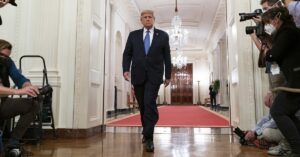The U.S. launches major campaign in Red Sea targeting Houthis
The United States military has launched an extensive offensive dubbed "Operation Rough Rider" against the Iran-backed Houthi organization in the Red Sea.
The campaign began on March 15, aiming to undermine Houthi military strength and reestablish freedom of navigation.
Since its inception, Operation Rough Rider has aimed to dismantle the combat capabilities of the Houthi group, a force supported by Iran. The operation's primary goal is to secure safe passageways in the Red Sea and curb the group's militant actions. U.S. forces have successfully struck more than 800 targets to date.
U.S. targets strategic Houthi locations
The targets of this military campaign have included key infrastructures crucial to the Houthi's military efforts. Strikes have focused on dismantling command centers, air defense systems, and locations where missiles and weapons are stored. According to sources, the actions have resulted in the deaths of hundreds of fighters, as well as senior leaders involved in missile and UAV operations.
Significant results have followed the campaign's intense focus, characterized by a notable reduction in the group’s offensive capabilities. Ballistic missile launches saw a decrease by 69%, and suicide drone attacks have diminished by 55%, indicating the U.S. has significantly impaired the Houthi ability to conduct operations.
Moreover, a strategic blow was delivered to the Houthis with the destruction of Ras Isa Port, an essential fueling hub that facilitated their operations. This aspect of the campaign is critical as it directly impacts the Houthi’s logistical capabilities.
Military and political criticisms surface
Despite tactical successes, the campaign has drawn criticism regarding its financial and resource implications. Concerns are prevalent over the depletion of munitions and the operation's costs, which have surpassed the $1 billion mark. These financial strains have led some to question the initiative’s long-term sustainability.
Further complicating the situation are reports of internal discord revealed through communications among former Trump administration officials. In a conversation disclosed by The Atlantic, there were expressions of doubt about the alignment of Operation Rough Rider with the current administration’s European policy stance.
"I think we are making a mistake," wrote Vance in the leaked chat, highlighting a sentiment of apprehension about the operation's broader implications.
U.S. deploys additional military resources
In response to ongoing threats, the U.S. has reinforced its presence in the region. Two aircraft carriers, alongside additional military units, have been deployed to solidify U.S. deterrence and ensure the operation’s objectives are met. The military's commitment to "ratchet up the pressure" remains steadfast.
Despite the intensifying efforts, critics continue to question the campaign's efficacy. There are significant doubts about whether the military gains will translate into long-lasting peace and stability in the affected region.
The highly secretive nature of the operation complicates transparent assessments. The military has underscored its intention to protect operational security by not disclosing specific details concerning current or future operations.
Houthi's intentions and regional dynamics
While Operation Rough Rider aims to curtail Houthi activity, the group persists in its stance against Western interests. Reports indicate their intention to escalate attacks on Western ships, purportedly to demonstrate support for Palestinian entities such as Hamas in Gaza.
This aspect highlights a broader geopolitical dynamic influencing the region, where multiple international stakeholders have vested interests. The U.S. military’s strategic maneuvers are thus set against a backdrop of complex international relations.
As the operation continues, its final outcomes will be pivotal in determining the future landscape of the region's security and stability. The U.S. government faces the challenge of balancing military action against economic costs and strategic goals.




